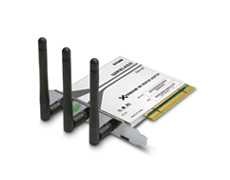The most powerful is the SMC 2532W-B, but because it is too powerful, Singapore rejected it.
Usually the standard 802.11b/g (24 GHz) type of cards are used by most people. There is an up-and-coming WiFi standard 802.11n which can operate in either the 2.4GHz or 5GHz unlicensed bands. More advantages are:
Less crowding. There are only 14 channels in the 2.4GHz band. They overlap and they've long been crowded. Wireless phones, microwaves, bluetooth devices, and other wireless access points are blasting throughout this entire band, causing massive interference, especially in urban environments. For now, the 5GHz band is pretty much barren, even in big cities.
The 5GHz band should also be slower to fill up as the 5GHz unlicensed band is significantly larger than the 2.4GHz one and thus contains many more 20MHz channels. This means, as more 5GHz-class devices churn out, there will still be less crowding and more opportunities to channel-bond.
Increased range. 802.11n takes advantage of spatial diversity (which has been quite standard in the mobile phone industry for years with the use of dual- and quad-pole antennas) to improve the signal strength at great distances.
Speed claims are for comparative purposes only. Actual speed varies with environment, equipment and other factors and will be less, while range may vary due to number of users, interference, transmission barriers (such as walls and building material), and other factors.
So, in the end, you still have to stick to the normal cards (they are good enough) sold in the market. Since every country has a bandwidth limitation for security purposes, it is very difficult for a lot of countries to liberalize their skies, although there are better devices out there. IEEE announced that it would release the second version of this draft (802.11n) for approval. As for fully compliant hardware, the Wi-Fi Alliance doesn't plan to certify anyone until later this year or even 2008.





